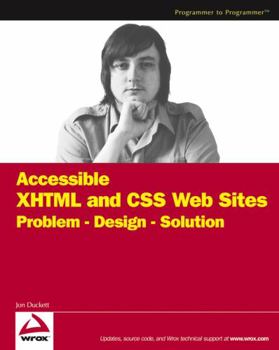Accessible XHTML and CSS Web Sites: Problem - Design - Solution
Shows Web developers how to make the transition from HTML to XHTML, an XML-based reformulation of HTML that offers greater design flexibility Demonstrates how to work with CSS (Cascading Style Sheets)-now supported by ninety percent of browsers and integral to new site-building tools from Macromedia and others-and implement a consistent style throughout and entire site Explains how to make a site accessible to people with impaired vision, limited hand use, dyslexia, and other issues-now a legal requirement for many sites in the U.S. and the U.K.
Format:Paperback
Language:English
ISBN:0764583069
ISBN13:9780764583063
Release Date:April 2005
Publisher:Wrox Press
Length:450 Pages
Weight:1.60 lbs.
Dimensions:1.0" x 7.4" x 9.2"
Customer Reviews
2 ratings
Goes beyond and explains it all
Published by Thriftbooks.com User , 19 years ago
This book not only explains how to do write in XHTML and CSS but it tells you why the W3C has changed its standards and why you should write in these two recommendations. It gives you thoroughly explained examples, and explains it in different ways to make you sure that you get it in case you didn't the first time. This is an easy book to read but it takes some time as it educates you about related topics that you might want to know about. Not only do you get to learn XHTML and CSS but you also get to update a website the publisher provides to put your new skills to practice and make sure you get it in your head. It also makes a good reference book as it explains CSS properties in detail and their values. Now adays accesibility is a key tool for websites and that's what you'll learn at the end of the book. I recommend this book to anyone who already knows HTML and has written websites in HTML (if you dont, dont buy this book to start with) that is willing to take their skills to the next level.
Eases the Transition
Published by Thriftbooks.com User , 19 years ago
OK, so you really know that you need to move on to Style Sheets and the new version of HTML. But you've put it off. The books on XHTML and CSS are long and tedious, and written for beginners so they contain a lot of fluff that you already know. This book is different. It starts with the presumption that you are already an HTML programmer. In fact you are probably running a site that has a few hundred pages on line and you don't want to go redo the whole thing. This book starts with a fictional web site that uses good HTML 4.0 as was proper in the late 1990's. It's a typical site with lots of tables within tables as was the style of the day. The first thing that he does is go re-write the HTML into XHTML, removing the commands that handle the style of the presentation. Going to XHMTL is a pretty straightford thing, but without the style aspects you have a pretty dull page. Second he says let's use CSS to make the page pretty once again. Since you've seen the pages. And you've looked at the HTML that generated them, the task is a conversion, not a design the page problem. This probably matches your real problem a lot better than the way most books cover the subject. Third is the first word in the title: Accessible. There are now laws coming into effect that say a web site should be accessible to people with various disabilities. What does this mean, and how must you think about page design to make the site accessible? Finally there is a chapter on what's coming. The web is dynamic and the rules are still changing. This chapter covers the things that are being considered, designed, or discussed about in the committees that make the rules. This is what you will be having to learn next.





